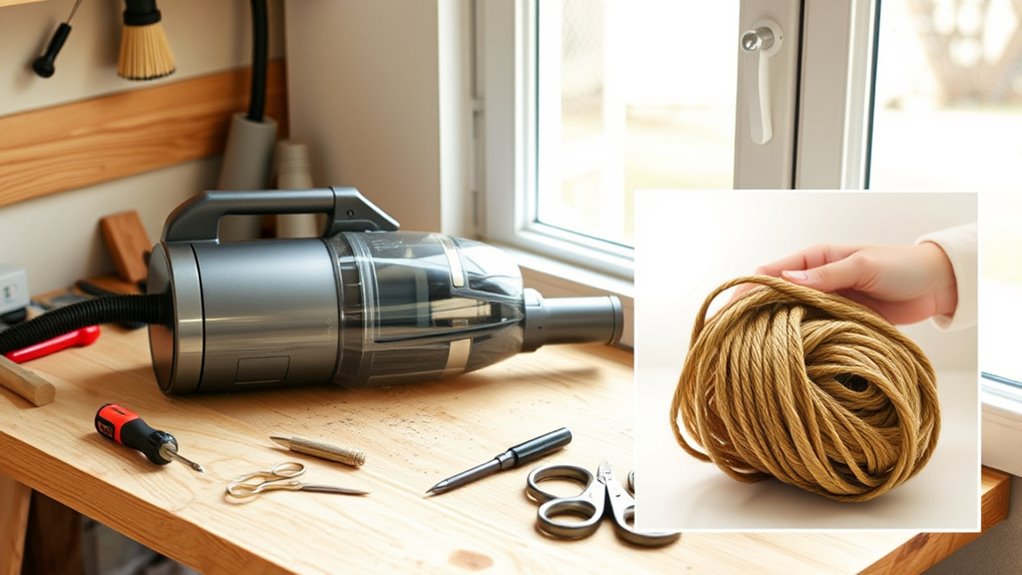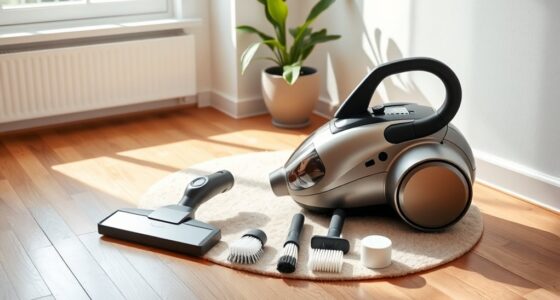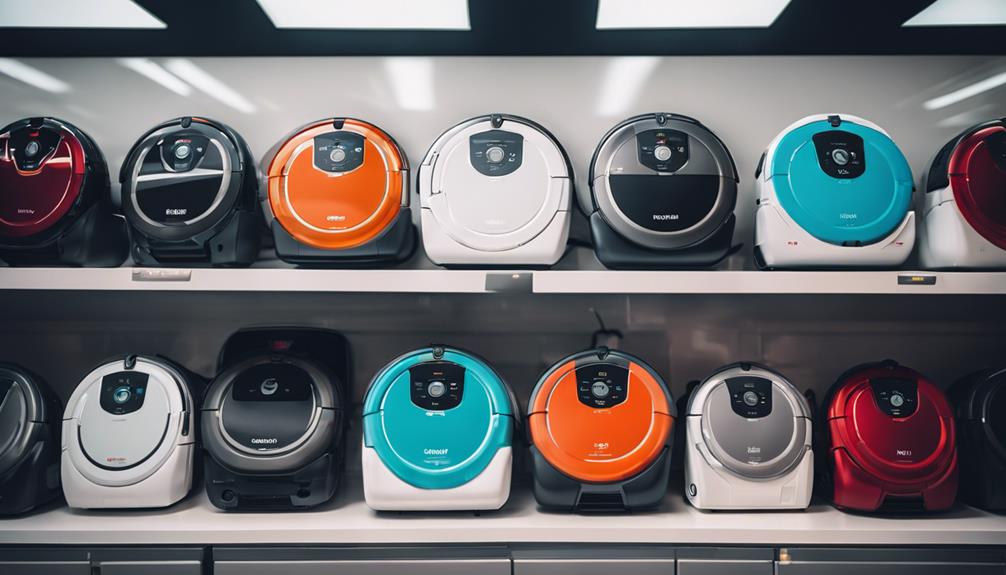When troubleshooting vacuum issues, start by checking for common symptoms like loss of suction or unusual smells. Inspect filters, empty dust bins, and look for clogs in hoses and the brush roll. Clean your vacuum’s internal components to reduce odors and improve performance. If it’s noisy or overheating, make sure everything’s properly connected and check for obstructions. Regular maintenance helps maintain efficiency, and there’s more you can do to keep your vacuum in top shape!
Key Takeaways
- Regularly inspect and clean filters to prevent clogs and maintain suction power.
- Check for blockages in hoses and brush rolls to ensure optimal airflow.
- Empty dustbins or replace vacuum bags frequently to avoid unpleasant odors.
- Allow the vacuum to cool for at least 30 minutes if it overheats during use.
- Maintain the vacuum by cleaning or replacing belts and inspecting electrical connections.
Common Symptoms of Vacuum Issues
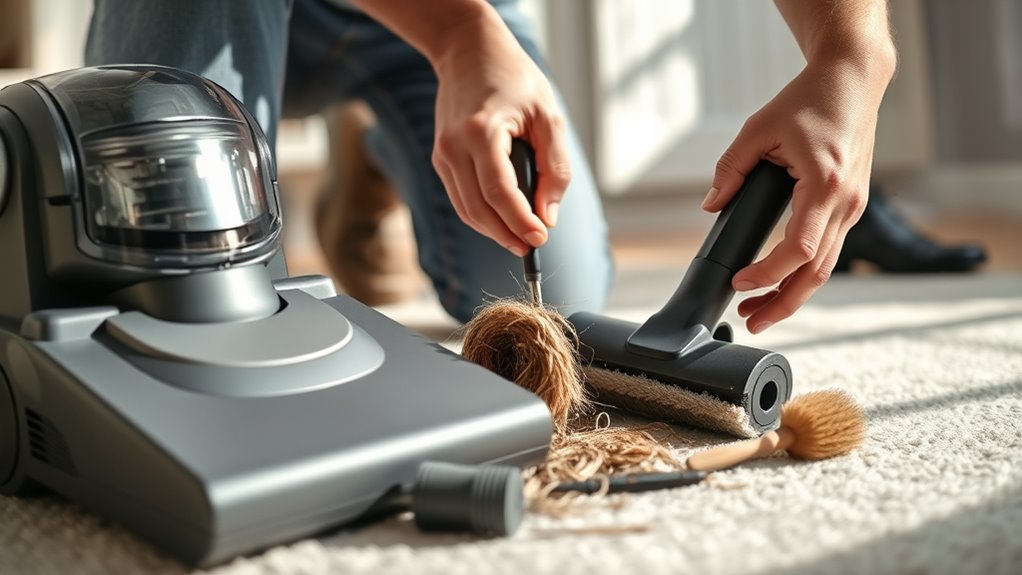
Have you noticed your vacuum not performing like it used to? One common symptom is a loss of suction power, often caused by clogged filters or full dust bins. Top-rated vacuums are designed to maintain strong suction, so considering an upgrade might be beneficial. Additionally, many budget-friendly options offer high suction power without high costs.
First, check for blockages in hoses and the brush roll, as these can severely hinder performance. If your vacuum keeps shutting off, it might be overheating due to airflow restrictions, or there could be an issue with the electrical system. Ensuring proper energy consumption can also help prolong your vacuum’s lifespan and efficiency.
Check for hose and brush roll blockages to prevent performance issues; overheating may indicate airflow restrictions or electrical problems.
Unusual odors can also indicate trapped dirt or debris, which you can usually fix by cleaning or replacing the filters. Regular maintenance, including checking the filtration systems, can help prevent these issues from arising in the first place. Additionally, using a vacuum with advanced cleaning technology can significantly reduce the chances of such problems.
Finally, verify the brush roll is spinning properly; if it’s not picking up debris, inspect the drive belt and remove any tangles for peak function.
Troubleshooting Unusual Smells
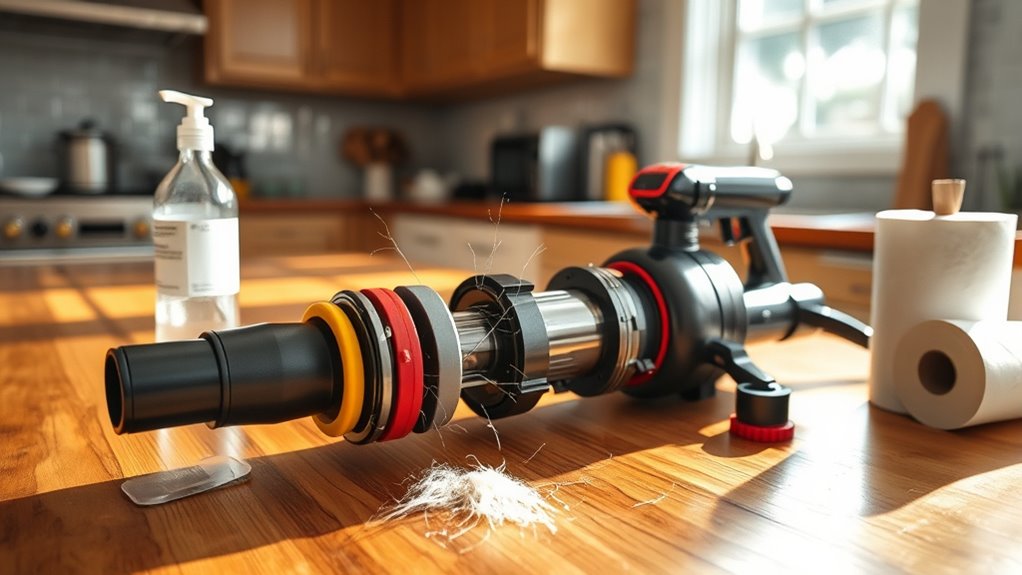
If your vacuum’s giving off unusual smells, it’s essential to identify the source first.
Start by checking the dirt fan, filters, and hoses for any buildup or blockages. Regular filter replacement can significantly reduce odors caused by trapped allergens and debris. Additionally, utilizing HEPA filtration can help eliminate odors by effectively capturing small particles. Cleaning these components can help restore your vacuum’s fresh scent and improve its performance. Additionally, consider using advanced filtration systems to reduce odors caused by trapped allergens and debris. You can also enhance your vacuum’s performance by adding a few drops of essential oils to the filters, which will not only provide a pleasant scent but may also help improve indoor air quality. Regular cleaning of these components is crucial for optimal sprayer performance.
Identify Source of Odor
When your vacuum cleaner starts emitting unusual smells, it’s a clear sign that something’s amiss.
To identify the source of the odor, follow these steps:
- Check for blockages in the hose or brush roll.
- Inspect and clean or replace dirty filters, as filter maintenance is crucial for optimal performance. Regular home maintenance can also prevent buildup that leads to odors.
- Empty the dustbin or replace vacuum bags regularly.
- Look for pet hair or organic matter inside the vacuum. Regular grooming can significantly reduce pet hair accumulation and help maintain cleaner appliances.
- Perform a thorough cleaning of internal components. Additionally, maintaining color accuracy in your home appliances can enhance overall performance and minimize unpleasant odors.
Additionally, regular cleaning and servicing can enhance appliance efficiency and prevent odors from developing in the first place.
Clean Dirt Fan
Unusual smells can often be traced back to a dirty dirt fan, which tends to collect dust and debris over time. To maintain peak vacuum performance, you should prioritize regular maintenance. Here’s how to troubleshoot common vacuum issues related to the dirt fan:
| Action | Purpose |
|---|---|
| Clean the dirt fan | Eliminates dust buildup and odors |
| Replace the dirt fan | Guarantees efficient functioning |
| Inspect internal components | Identifies other potential odor sources |
To access the dirt fan, unplug the vacuum, remove attachments, and unscrew the bottom cover. Cleaning or replacing the dirt fan can effectively eliminate unusual smells. If the odor persists, inspect the motor and other internal components for further issues.
Inspect Filters and Hoses
Inspecting filters and hoses is essential for maintaining your vacuum and preventing unpleasant smells. Here’s what you should do:
- Regularly check filters for dirt and debris to avoid unusual smells. HEPA filters are particularly important for effective odor control. In addition, ensuring that you select a model with high filtration efficiency can greatly reduce odors.
- Examine hoses with a flashlight for any blockages that could trap odors.
- Make certain filters are completely dry before reinserting them, as damp filters can promote mold. Maintaining optimal performance ensures your vacuum operates efficiently. Regularly inspecting your vacuum can help identify common issues before they escalate.
- Replace them as needed, especially HEPA filters, to maintain ideal airflow and efficiency.
- If smells persist, examine the vacuum’s motor and internal components for trapped debris or damage.
- Additionally, consider using essential oils like eucalyptus oil in a diffuser near your vacuum to help neutralize any lingering odors.
Fixing Low Suction Force
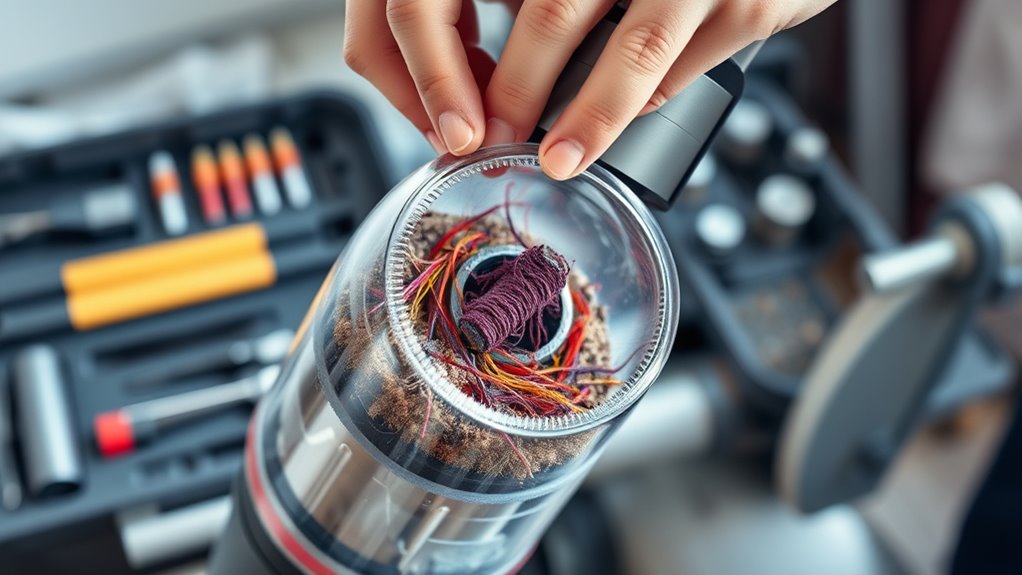
If your vacuum’s suction isn’t up to par, start by checking for clogs in the hoses and attachments. Next, inspect the filters and bags; dirty filters or a full bag can seriously limit airflow. Additionally, maintaining your vacuum is essential, just as investing in precious metals can enhance portfolio resilience. Addressing these issues can restore your vacuum’s cleaning power quickly. Regularly replacing cat furniture with new options can also help in creating a cleaner home environment, as it reduces the likelihood of fur and debris buildup. Additionally, regular maintenance, such as changing filters and cleaning brushes, can help prevent suction problems in the future.
Check for Clogs
To guarantee your vacuum maintains peak suction power, start by checking for clogs throughout the system. Even small obstructions can notably reduce suction, so be thorough.
Here’s what to do:
- Inspect the hose and attachments for blockages, using a flashlight to check for any obstructions.
- Verify the dust cup or vacuum bag isn’t overfilled, as an overfilled bag can restrict airflow.
- Remove dirty filters and either clean or replace them, since clogged filters can restrict performance.
- Examine the brush roll for tangles; removing any debris can help it spin effectively.
- Finally, make certain all components are properly reattached to avoid air leaks that can diminish suction.
Taking these steps will help restore your vacuum’s efficiency.
Inspect Filters and Bags
Filters and bags play an essential role in your vacuum’s performance, and neglecting them can lead to frustrating low suction. To maintain peak vacuum performance, regularly inspect filters and bags.
Start by checking the dustbin; empty it or replace the bag if it’s full. Dirty or clogged filters can greatly reduce airflow, so make certain to clean or replace filters according to the manufacturer’s guidelines.
Look for visible dirt and debris, and verify filters are completely dry before reinserting. Don’t forget to check the vacuums for obstructions in the hose and brush head, as removing blockages can restore suction force.
Setting reminders for monthly cleaning and replacing filters will help keep your vacuum running at its best.
Addressing Excessive Noise
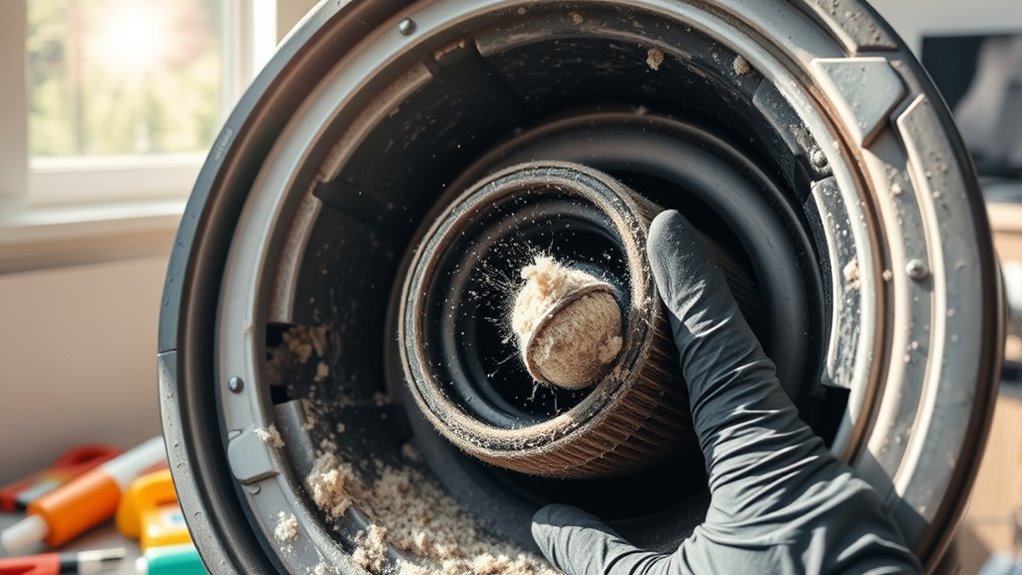
When you notice excessive noise from your vacuum, it’s often a sign of underlying issues that need attention.
To tackle this problem, consider the following steps:
- Inspect the hose for clogs or blockages.
- Check the brush roll for tangled hair or debris.
- Clean the filters to improve airflow and reduce noise.
- Examine the belt for wear or breakage, as a malfunctioning belt can produce strange sounds.
- Perform regular maintenance to keep your vacuum running smoothly.
Resolving Overheating Problems

Overheating issues in your vacuum can disrupt your cleaning routine and signal potential problems that need addressing. Common causes include clogged filters or hoses that restrict airflow, forcing the motor to work harder and increasing temperatures.
To prevent overheating in vacuums, regularly clean or replace filters as specified in your user manual. After extended use, let your vacuum cool down for at least 30 minutes to avoid triggering the thermal shut-off feature.
Inspect for blockages in the brush head and hose, removing any debris you find. If overheating persists despite these efforts, it may indicate a malfunctioning thermal protector or motor issue, which requires professional evaluation to resolve effectively.
Maintaining Your Vacuum for Optimal Performance
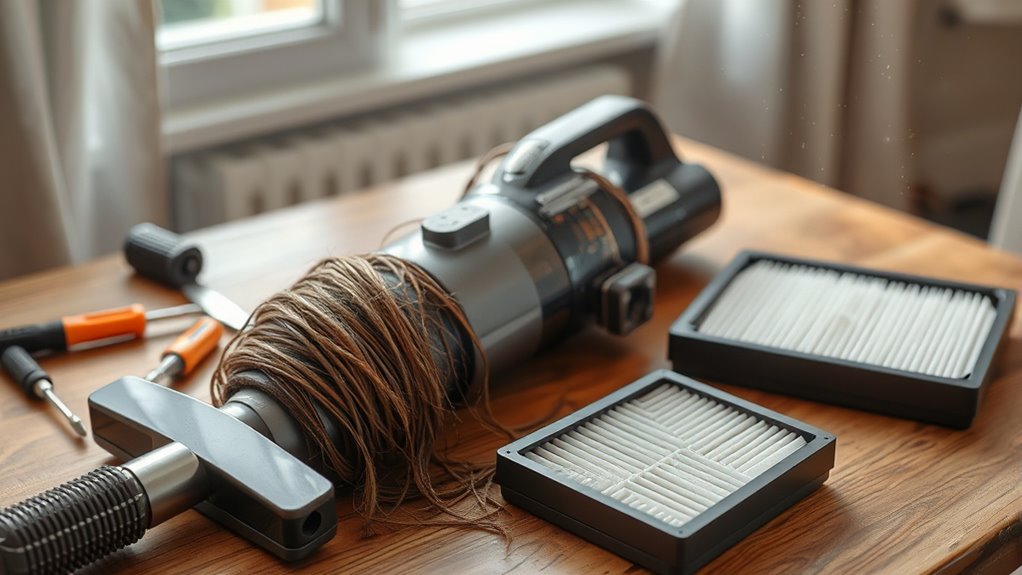
To keep your vacuum performing at its best, regular maintenance is essential. Neglecting these tasks can lead to decreased efficiency and even overheating.
Here’s how you can guarantee peak performance:
- Regularly empty or replace vacuum bags or canisters to prevent loss of suction.
- Clean or replace filters monthly to maintain peak airflow; check your manual for specifics.
- Inspect and clean the brush roll to remove hair and debris, cutting away any tangles.
- Check for blockages in hoses and attachments to avoid reduced suction power.
- Perform routine maintenance checks on belts and electrical connections, replacing any damaged parts.
Frequently Asked Questions
What Is the Most Common Problem With Vacuum Cleaners?
The most common problem with vacuum cleaners is loss of suction power. You might notice this issue when your vacuum struggles to pick up dirt or debris.
Often, it’s caused by clogged filters, full dust bags, or obstructions in the hose or brush head. Regularly checking and maintaining these components can help restore performance.
If you’re facing this issue, don’t hesitate to inspect your vacuum for any blockages or necessary replacements.
How Do You Troubleshoot a Vacuum Cleaner?
To troubleshoot your vacuum cleaner, start by checking if it’s plugged in and the power cord is intact.
Then, inspect the filters and dustbin—clean or empty them if they’re clogged.
Look for blockages in the hose and brush head, using a flashlight if necessary.
Don’t forget to check the brush roll for tangles and guarantee the drive belt’s in good condition.
Listen for unusual noises that might indicate deeper issues needing repair.
How Can I Make My Vacuum Work Better?
Think of your vacuum as a loyal companion, ready to tackle every mess. To make it work better, regularly empty the bag or canister; a full dustbin stifles its spirit.
Clean or replace filters to keep it breathing easy. Inspect the hose and brush roll for blockages, and remove tangled hair.
Finally, schedule maintenance checks to guarantee it remains your trusty cleaning partner, always prepared to conquer dust and dirt.
Why Has My Vacuum Suddenly Stopped Working?
If your vacuum’s suddenly stopped working, it could be due to several reasons.
First, check the power supply; a blown fuse or tripped circuit breaker might be the culprit.
Inspect the power cord for damage or loose connections.
Don’t forget to test the on/off switch too.
Finally, overheating from extended use or clogged filters can trigger an automatic shut-off.
If it’s still not working, you may need professional help.
Conclusion
To sum up, tackling common vacuum issues can save you time and money. Did you know that nearly 25% of vacuum problems stem from clogged filters and hoses? By keeping your vacuum clean and well-maintained, you can boost its performance and extend its lifespan. So, don’t hesitate to apply these DIY fixes the next time you encounter a problem. With a little effort, your vacuum can keep your home spotless and functioning like new!
